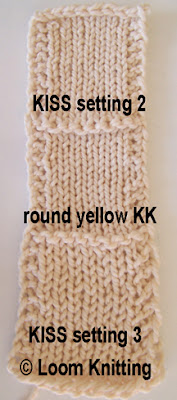
I've recently had the opportunity to do some experimenting with a new type of knitting loom, the
KISS loom. These looms look like double rakes without the gap in the center for the knitting to go through. But, the knitting is done only on the front board with the pegs, and the knitting comes off the loom behind the back board. The back board has pins, which are used only to achieve a specific gauge. So far, I've been able to replicate every basic technique I've done with KK round looms on the KISS looms, with a slight modification to the wrapping method to incorporate using the pins.
The pin board is used to regulate the bar portion of the stitch, or the amount of traveling yarn used between wrapping one peg and the next. It affects the tension of the resulting stitches, which impacts the gauge (number of stitches and number of rows per inch) of the completed knitting.
What is so exciting about these looms is that they can be adjusted to achieve the exact gauge you want! Needle knitters switch needles to get a different gauge. Now, loom knitters can adjust the loom to make the knit gauge larger or smaller. What this means is that no matter how loosely or tightly you knit, you will be able to exactly match the gauge the designer got when creating the pattern you want to make!
The looms are also modular, so you can assemble the pieces according to the number of pegs you want to use, especially handy for making socks and hats and other tube-style projects in different sizes. Customizable stitch size and quantity -- what else could a loomer want?
I'll have more to share about these looms in the future, but for now I'd like to show you three different knit pieces, created on the same loom from the same skein of yarn. The different knitting gauges are achieved simply by adjusting the distance between the peg board and the pin board. These are made with the basic settings, but it is very easy to fine tune the settings to get a knit gauge in between these.
All swatches are worsted weight Red Heart yarn in stockinette (flat knit) stitch.

Setting 1: 1 inch = 4-1/2 stitches and 6 rows

Setting 2: 1 inch = 3 stitches and 4 rows

Setting 3: 1 inch = 2-1/2 stitches and 3-1/2 rows
 This swatch shows that the KISS looms can handle bulky yarns. The yarn I used was from my stash with no label, but I believe it's Lion Brand Wool-Ease Thick and Quick. I modified the wrap method to use every other peg, and two pins per peg. The top section is done with the KISS loom on Setting 2, the middle section is done on the round yellow KK loom, and the bottom section is done with the KISS loom on Setting 3.
This swatch shows that the KISS looms can handle bulky yarns. The yarn I used was from my stash with no label, but I believe it's Lion Brand Wool-Ease Thick and Quick. I modified the wrap method to use every other peg, and two pins per peg. The top section is done with the KISS loom on Setting 2, the middle section is done on the round yellow KK loom, and the bottom section is done with the KISS loom on Setting 3.



















